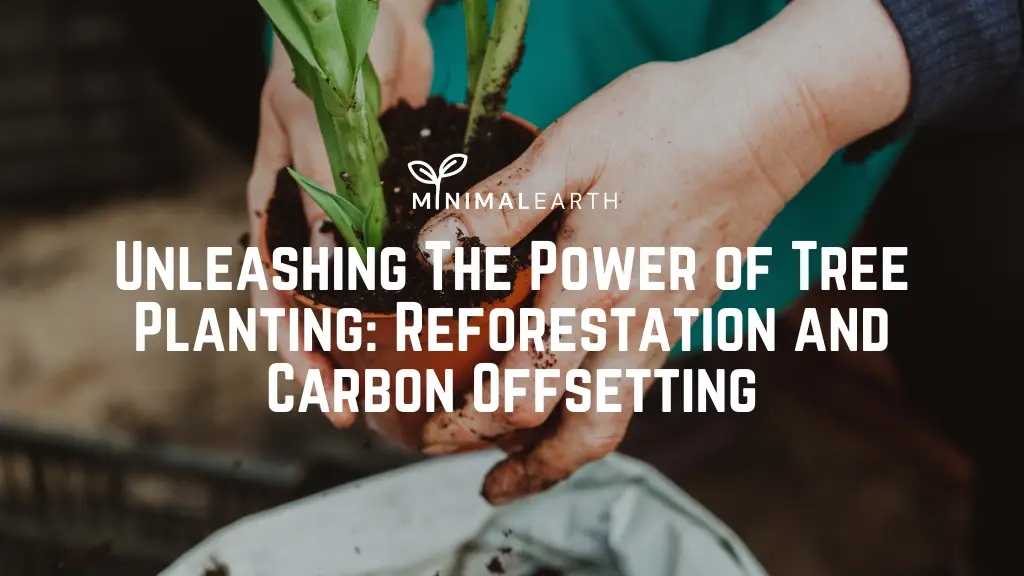In a world grappling with the dire consequences of climate change, the need for effective solutions has never been more pressing. One such powerful solution lies in the practice of tree planting, a key component of reforestation and carbon offsetting efforts. In this comprehensive article, we’ll explore the remarkable potential and benefits of tree planting, how it contributes to combating climate change, and how forward-thinking organizations like Minimal Earth are playing a pivotal role in this endeavour through eco-friendly products like copper bottles.
1. Understanding the Climate Crisis
To appreciate the transformative potential of tree planting, we must first comprehend the severity of the climate crisis and its far-reaching implications.
2. The Role of Trees in Climate Mitigation
Trees are nature’s carbon sponges, playing a crucial role in capturing and storing carbon dioxide, a major greenhouse gas responsible for global warming. Through a process called photosynthesis, trees absorb carbon dioxide from the atmosphere, release oxygen, and store carbon in their trunks, branches, and roots.
3. Tree Planting as a Solution
Tree planting, a form of reforestation, involves strategically planting trees in areas where deforestation or degradation has occurred, thus replenishing lost forests. This practice has gained recognition as a potent climate mitigation strategy and a means of carbon offsetting.
4. Benefits of Reforestation
Reforestation yields a plethora of benefits, including carbon sequestration, habitat restoration, improved air and water quality, and economic opportunities for local communities.
5. Minimal Earth’s Commitment to Reforestation
Discover how socially responsible companies like Minimal Earth are taking steps to offset their carbon footprint and support reforestation initiatives.
6. Tree Planting Projects around the World
Explore notable global tree planting projects, such as the Great Green Wall and efforts in the Amazon Rainforest, and learn about community-led initiatives making a difference.
6.1. The Great Green Wall
The Great Green Wall is an ambitious pan-African initiative aimed at combating desertification, land degradation, and climate change by planting a wall of trees across the Sahel region. Stretching across 20 African countries, this project seeks to restore degraded land, provide food security, and create jobs for millions of people.
6.2. Reforestation in the Amazon Rainforest
The Amazon Rainforest, often referred to as the “lungs of the Earth,” has faced extensive deforestation in recent decades. Reforestation efforts in the Amazon aim to restore its ecological balance and protect its unparalleled biodiversity.
6.3. Community-Led Reforestation Initiatives
Local communities play a crucial role in reforestation efforts. Community-led projects empower residents to restore their local environments, improve their livelihoods, and build resilient ecosystems.
7. How Individuals Can Get Involved
Empower individuals with practical ways to contribute to tree planting efforts, from planting trees locally to supporting reputable reforestation organizations.
7.1. Planting Trees Locally
Tree planting is not limited to large-scale projects; individuals can make a meaningful impact by planting trees in their communities. Consider participating in local tree-planting events, joining environmental organizations, or starting your tree planting initiative.
7.2. Supporting Reforestation Organizations
Many organizations specialize in reforestation and carbon offsetting. By supporting these organizations through donations or partnerships, individuals can contribute to tree planting efforts on a larger scale.
8. Challenges and Obstacles
While tree planting offers immense promise, it is not without its challenges, including deforestation pressures, limited resources, and climate-related obstacles.
Reforestation faces challenges such as land availability, funding constraints, and the need for long-term monitoring and maintenance. Additionally, climate change-induced shifts in precipitation patterns and the increased frequency of wildfires can threaten reforestation efforts.
Addressing these challenges requires collaborative efforts among governments, organizations, and individuals, as well as innovative solutions to adapt to changing environmental conditions.
9. The Future of Tree Planting: A Global Effort
Consider the future of tree planting and reforestation efforts, recognizing the collective power of communities, businesses, and governments to drive meaningful change.
The future of tree planting and reforestation holds tremendous promise. As awareness of the climate crisis continues to grow, more individuals, organizations, and governments are committing to tree planting and carbon offsetting as essential strategies for mitigating climate change.
Collaborative global initiatives, combined with advancements in technology and sustainable forestry practices, are poised to accelerate reforestation efforts. Governments are setting ambitious targets to restore vast forested landscapes, and innovative approaches are emerging to ensure the success and sustainability of tree planting projects.
10. Conclusion: Nurturing the Green Hope
As we conclude this exploration of “The Power of Tree Planting,” it’s evident that trees hold the key to a more sustainable future. By supporting reforestation and tree planting initiatives and embracing eco-friendly products like copper bottles from organizations like Minimal Earth, we can collectively combat climate change and nurture a greener, more resilient planet.
In a world where environmental conservation is paramount, tree planting stands as a testament to our capacity to reverse the course of climate change and protect the planet for generations to come. Together, we can harness the power of tree planting to create a sustainable and vibrant future for all.

